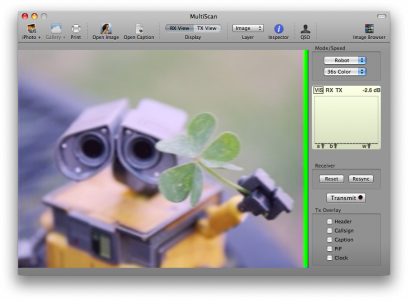I suspect the world would be better if that percentage were even greater.
Success: Robot36 encoder works…
Well, it works! Using the information in the paper I linked earlier in the day, I spent some time and managed to code up a Robot36 SSTV encoder. Above, you see the image decoded by Multiscan on my Macbook. Here’s a link to the .wav file:
Comment from Brad
Time 1/22/2011 at 12:24 am
Cool stuff, I’m looking to build an AVR-based board to do SSTV (or maybe one of those cheap STM32 boards). BTW, your download link is broken.

Comment from Bernard
Time 3/4/2011 at 10:22 am
Hello Mark,
That’s a great experiment, I would like to try it. Can you send me the robot36.c file? The link is broken on your site. Thank you! Have you done further experiments with SSTV on arduino?
Bernard Van Haecke KI6TSF
bernard.vanhaecke@gmail.com